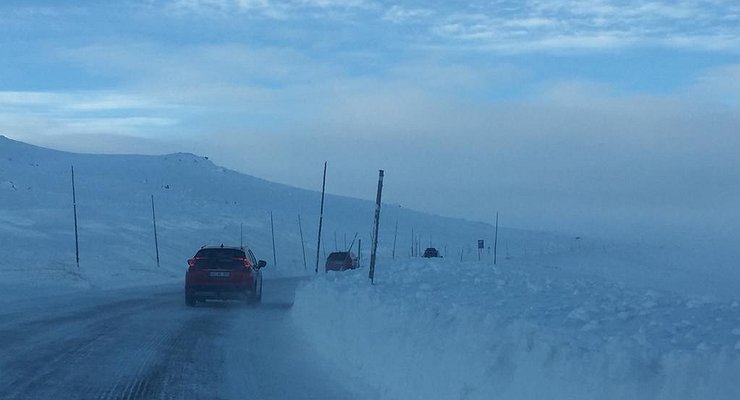Why are long, thin posts placed on the sides of many roads?
- September 12, 2022
- 0
On the northern highways of our Russia, and indeed in Scandinavia, there are tall poles lining the roads. Thin, no sign to hang, but very long – at
On the northern highways of our Russia, and indeed in Scandinavia, there are tall poles lining the roads. Thin, no sign to hang, but very long – at

The further north the traveler climbs, the more incomprehensible and inexplicable he becomes. “In the north”, where life flows according to different canons of the middle and southern stripes, there really are their own rules and regulations, which “everyone who comes in here” must abide and accept. Don’t be surprised that no more than ten or fifteen gallons of fuel are sold at the gas station, as there isn’t much left in the tanks, another traveler can’t have enough. It pays to slow down on the side of the road, because the next car stops immediately to make sure everything is in order. Such rules. Winter is a dangerous thing and all locals and outsiders know about it.
Interesting features of the northern road are noticed by observant travelers who have climbed in regions close to the Arctic Circle (and not only): on the side of the road there are often, sometimes even a few meters apart, high poles or plastic poles . They cannot withstand a board or a camera, they are not visually connected to each other, but they are installed stably and regularly where nature practices ‘true winter’. What are those for?
It’s hard to imagine that these sticks stuck along the road indicate the presence of that same road! Snowfall can cover the trail so it just can’t be seen, so snow plows only go past the landmarks, giving way to cars and trucks. A novice traveler smiles and asks about the height: really, why make poles so tall?
It makes no sense to compare the winter in the central zone and even in Karelia with a real snowy winter in Siberia, on the Kola or Scandinavia: sometimes the height of the snow cover reaches three or four meters, so that only a small “tail” left over from the posts, and the cars literally drive in the corridor of snow. The houses along the road are littered to the roof, some villages can only be reached by special equipment or by air, and the sun rising 45 minutes a day is little consolation on a polar night.
So there is no mysticism and belief in the pillars on the road: despite the fact that the road was marked with poles long before the appearance of the internal combustion engine, this proven technique is still relevant today. When driving through the hidden paths of the Arkhangelsk or Murmansk region in the golden autumn, pay attention to these pillars. That’s what “snow fell” means, and not the shy resemblance of precipitation, which the municipal services of the capital heroically fight every winter.

The further north the traveler climbs, the more incomprehensible and inexplicable he becomes. “In the north”, where life flows according to different canons of the middle and southern stripes, there really are their own rules and regulations, which “everyone who comes in here” must abide and accept. Don’t be surprised that no more than ten or fifteen gallons of fuel are sold at the gas station, as there isn’t much left in the tanks, another traveler can’t have enough. It pays to slow down on the side of the road, because the next car stops immediately to make sure everything is in order. Such rules. Winter is a dangerous thing and all locals and outsiders know about it.
Interesting features of the northern road are noticed by observant travelers who have climbed in regions close to the Arctic Circle (and not only): on the verges quite often, sometimes even a few meters from each other, there are tall sticks or plastic poles. They cannot withstand a board or a camera, they are not visually connected to each other, but they are installed stably and regularly where nature practices ‘true winter’. What are those for?
It’s hard to imagine that these sticks stuck along the road indicate the presence of that same road! Snowfall can cover the trail so it just can’t be seen, so snow plows only go past the landmarks, giving way to cars and trucks. A novice traveler smiles and asks about the height: really, why make poles so tall?
It makes no sense to compare the winter in the central zone and even in Karelia with a real snowy winter in Siberia, on the Kola or Scandinavia: sometimes the height of the snow cover reaches three or four meters, so that only a small “tail” left over from the posts, and the cars literally drive in the corridor of snow. The houses along the road are littered to the roof, some villages can only be reached by special equipment or by air, and the sun rising 45 minutes a day is little consolation on a polar night.
So there is no mysticism and belief in the pillars on the road: despite the fact that the road was marked with poles long before the appearance of the internal combustion engine, this proven technique is still relevant today. Keep an eye out for these pillars as you pass the hidden golden autumn trails of the Arkhangelsk or Murmansk regions. That’s what “snow fell” means, and not the shy resemblance of precipitation, which the municipal services of the capital heroically fight every winter.
Source: Avto Vzglyad
I’m Sandra Torres, a passionate journalist and content creator. My specialty lies in covering the latest gadgets, trends and tech news for Div Bracket. With over 5 years of experience as a professional writer, I have built up an impressive portfolio of published works that showcase my expertise in this field.